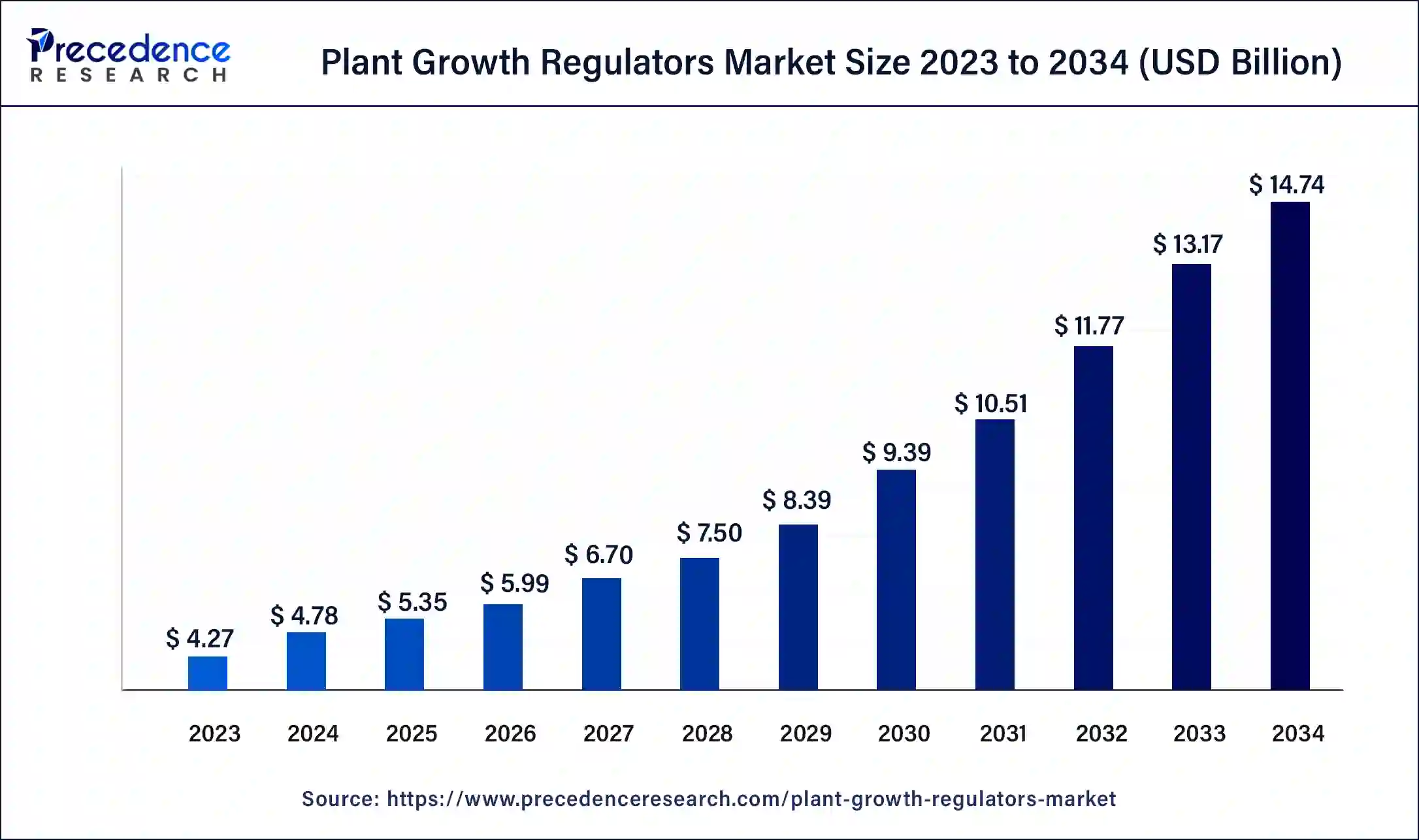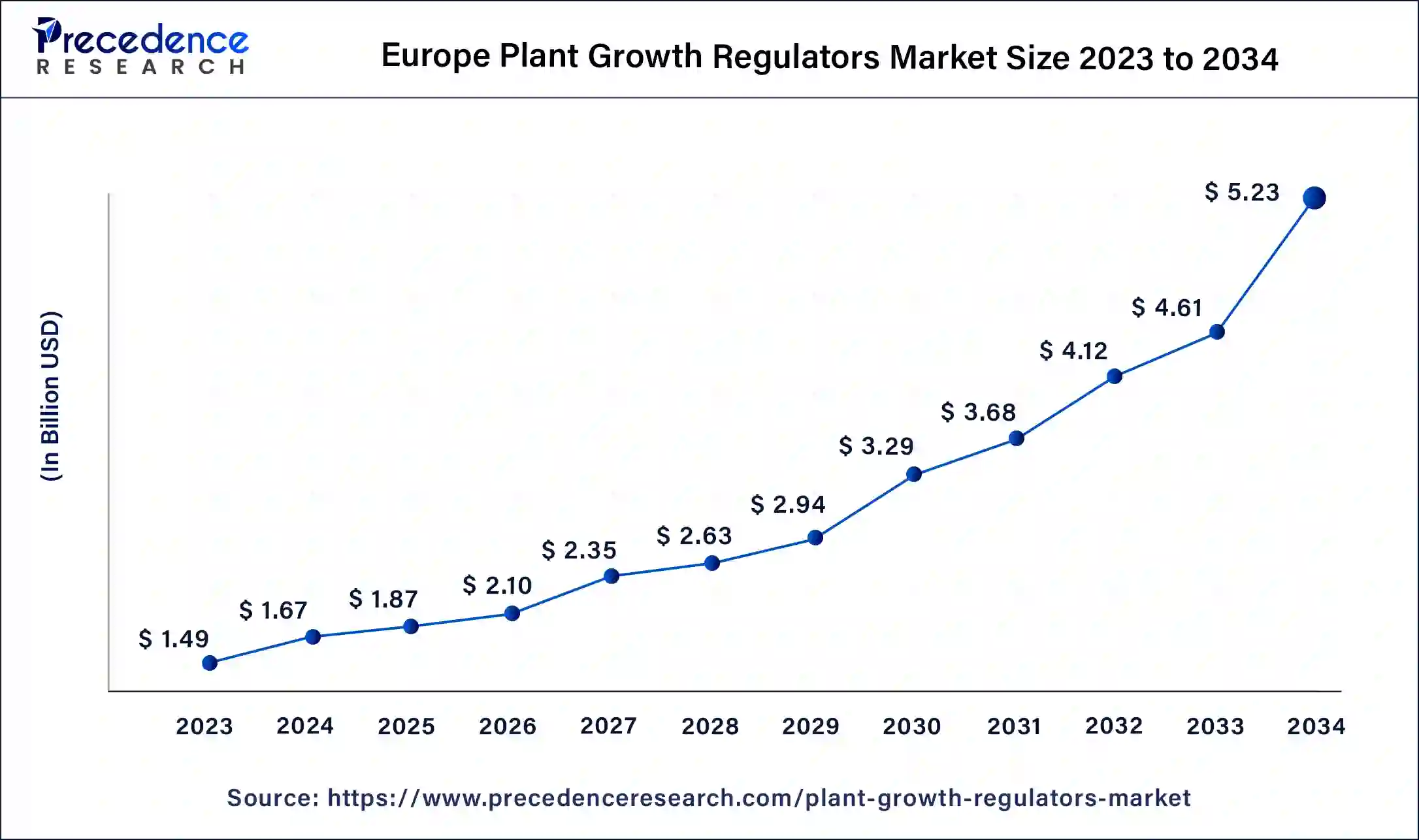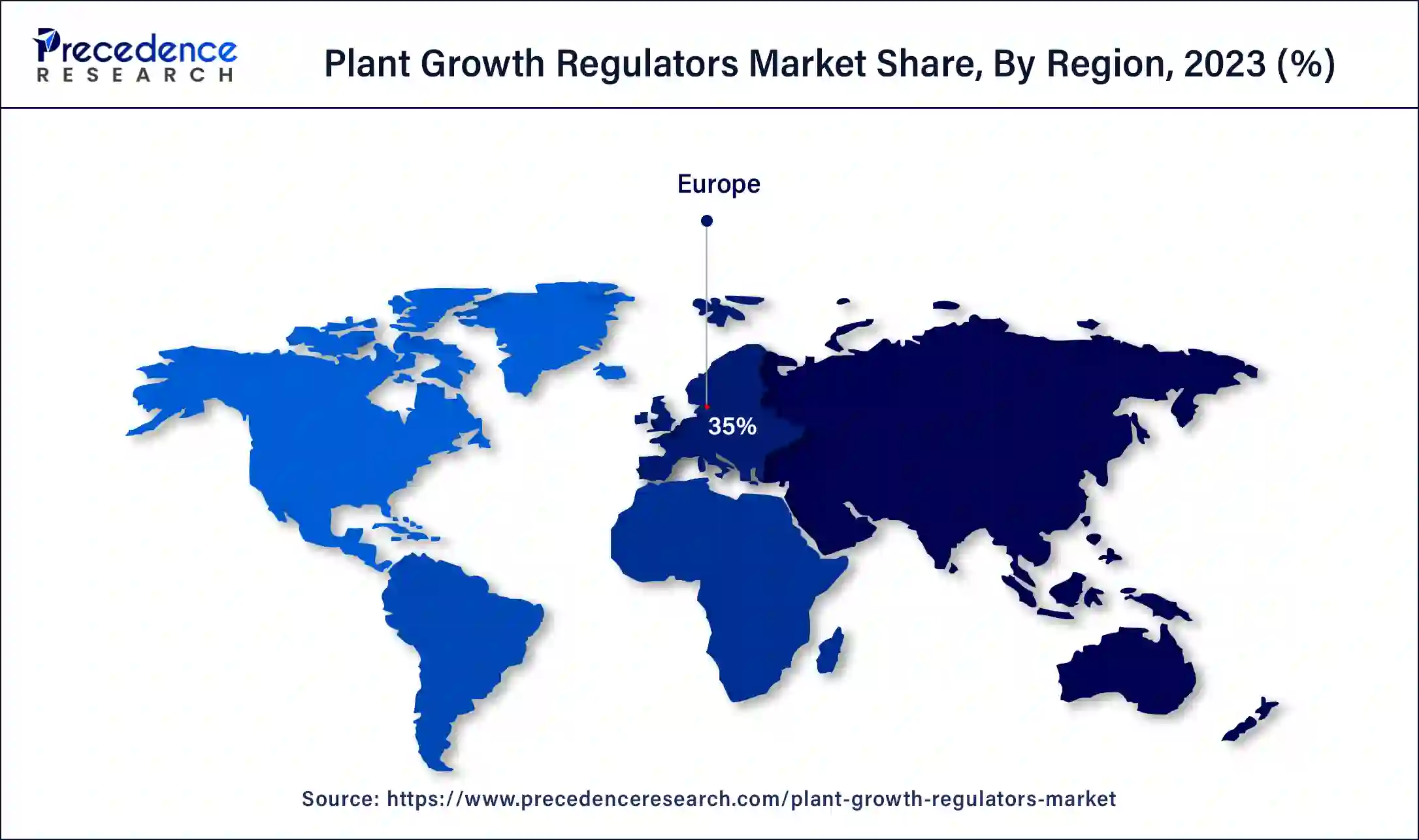List of Contents
Plant Growth Regulators Market Size and Forecast 2025 to 2034
The global plant growth regulators market size is projected to be worth around USD 14.74 billion by 2034 from USD 4.78 billion in 2024, at a CAGR of 11.92% from 2025 to 2034. Decreasing agricultural areas along with increasing demand for organic food is likely to be one of the key trends in the plant growth regulators market growth.

Plant Growth Regulators Market Key Takeaways
- In terms of revenue, the market is valued at $5.35 billion in 2025.
- It is projected to reach $14.74 billion by 2034.
- The market is expected to grow at a CAGR of 11.92% from 2025 to 2034.
- Europe dominated the plant growth regulators market with the highest market share of 35% in 2024.
- By product, the cytokinin segment dominated the global market in 2024.
- By product, the auxins segment is expected to experience notable growth in the market during the forecast period.
Role of AI in the Plant Growth Regulators Market
The integration of innovative imaging technologies with AI has launched as a powerful technique for real-time and non-invasive monitoring of plant health technologies such as deep learning and neural networks, along with pattern recognition, enabling the automated analysis of large datasets, which improve the precision and speed for plant stress detection. Furthermore, the ability of AI in plant stress physiology and its capability to overcome the limitations of conventional methods can transform the plant growth regulators market in the upcoming years.
- In September 2023, ICL Group, a leading global specialty minerals company, announced its agrifood innovation and investment platform, ICL Planet Startup Hub, which led an investment round in Agrematch, an artificial intelligence (AI) agriTech startup. The two companies agreed to launch a joint, multi-year program to use Agrematch's AI system to discover novel crop nutrition solutions and bring innovative products to ICL's global offerings.
Europe Plant Growth Regulators Market Size and Growth 2025 to 2034
The Europe plant growth regulators market size is exhibited at USD 1.87 billion in 2025 and is projected to be worth around USD 5.23 billion by 2034, poised to grow at a CAGR of 12.09% from 2025 to 2034.

Europe dominated the global plant growth regulators market in 2024. The region's dominance is linked to the innovative agricultural practices carried out since the technological advancement in this sector. The region's dominance is due to the adoption of plant growth regulators by many farmers to enhance the quality and yields. Furthermore, the country's favorable regulatory conditions, rising emphasis on sustainable agriculture, and advanced R&D activities are driving the growth of the region's market.
Additionally, the rising demand for high-value crops and higher consumption of natural plant regulators systems in agriculture sector have promoted the expansion of the market in Europe. Most of the pesticide manufacturers and dealers such as Bayer is headquartered in Europe. This has significant potential for the market to grow in European countries.

Asia Pacific is expected to grow at the fastest rate in the plant growth regulators market over the forecast period. The region is experiencing strong growth due to rising food requirements and the adoption of modern agricultural practices. Also, the growing population in the region has driven the demand for food, fueling the market's growth further. China, India, and Japan are the key market contributors in the region due to significant investments made by the governments of the respective countries in advanced agricultural practices.
List of 10 Leading Agricultural States in India (2024)
| S.No | State | Major Crops Grown |
| 1. | Punjab | Wheat, Rice, Cotton |
| 2. | Uttar Pradesh | Wheat, Sugarcane, Rice, Maize |
| 3. | Maharashtra | Sugarcane, Cotton, Rice |
| 4. | Madhya Pradesh | Soybean, Wheat, Rice |
| 5. | Rajasthan | Bajra, Wheat, Pulses, Oilseeds |
| 6. | Bihar | Rice, Wheat, Maize |
| 7. | Andhra Prades | Rice, Sugarcane, Chilies, Oilseeds |
| 8. | Karnataka | Coffee, Sugarcane, Rice, Oilseeds |
| 9. | Tamil Nadu | Rice, Sugarcane, Banana, Oilseeds |
| 10. | West Bengal | Rice, Jute, Pulses, Oilseeds |
Market Overview
Plant growth regulators are synthetic chemicals that mimic the hormones that plants naturally make. They usually do this by controlling and modifying plants' physiological processes to get desired results like enhancement in yield and quality. Some examples of this plant's growth regulators are auxins, cytokinins, and gibberellins. These chemicals also impact the overall development of plant cells, organs, and tissue. In the plant growth regulators market, growth inhibitors can increase crop productivity substantially, which can lead to high-yield formation in a short period.
Plant Growth Regulators Market Growth Factors
- A rise in the need for food production is expected to drive the plant growth regulators market growth shortly.
- Focusing on sustainable agricultural methods can contribute to market expansion further.
- Growth of the floriculture and horticultural sectors can fuel the plant growth regulators market growth.
- Research and development activities in the biotechnology sector will also have a positive impact on the plant growth regulators market growth soon.
- Rising Demand for Food- The population is growing at a rapid pace around the world, there is increased demand for more productivity in agriculture, putting pressure on your farmer to use plant growth regulators to increase crop outputs in order to maintain food security.
- Move Towards Organic Agriculture- The demand for wider organic and sustainable agriculture is accelerating the use of natural plant growth regulators because they are safer alternatives to synthetic agricultural inputs.
- Increased Technological Advancements- The development of new formulations and application methods of plant growth regulators are advancing effectiveness making these inputs easier to use and more appealing to farmers large and small.
- Government Support Programs- Subsidies for agricultural inputs, public awareness programs, and policies promoting agriculture are all encouraging the use of plant growth regulators, especially in developing world areas of the globe trying to modernize their agriculture.
Market Scope
| Report Coverage | Details |
| Market Size by 2034 | USD 14.74 Billion |
| Market Size in 2025 | USD 5.35 Billion |
| Market Size in 2024 | USD 4.78 Billion |
| Market Growth Rate from 2025 to 2034 | CAGR of 11.92% |
| Largest Market | Europe |
| Base Year | 2024 |
| Forecast Period | 2025 to 2034 |
| Regions Covered | North America, Europe, Asia-Pacific, Latin America, and Middle East & Africa |
Market Dynamics
Drivers
Growing demand for food due to growing population
increasing demand for food due to rising global population growth is one of the key factors driving the plant growth regulators market growth. The demand for food is rising in proportion to the increase in population worldwide, and to fulfill this need, it is important to cultivate more quality crop yields, which can only be possible by adapting to efficient agricultural practices. Additionally, plant growth regulators are extensively used in the farming sector to improve the quality of yield and protect crops from diseases and pests, which can propel market growth further.
- In December 2022, Dubai-based agrochemical company AgFarm introduced its entire product range in the Chhattisgarh market, which consists of herbicides, insecticides, fungicides, and plant growth regulators. The launch coincides with the Rabi crop sowing season in India, which typically starts in the winter season. AgFarm entered the Indian market almost a year ago and presently enjoys a presence in Punjab, Haryana, Uttar Pradesh, Rajasthan, Andhra Pradesh, Madhya Pradesh, and Telangana.
Restraint
Farmers' low awareness and education
Farmers might be unaware of the proper usage, benefits, and utilization of plant growth regulators, and there are some differences in their understanding of these tools. This can hurt the adoption rate, particularly with conventional and small-scale farmers. Moreover, Concerns related to the effect of the environment on plant growth regulators can hinder the plant growth regulators market growth soon.
Opportunity
Growth in the pharmaceutical industry
The growth in the pharmaceutical industry is the latest trend in the plant growth regulators market. The sector is mainly driven by unhealthy eating habits, changing lifestyles, and an aging population. Which then can lead to the prevalence of chronic diseases. Furthermore, this growth in the pharmaceutical market is also accomplishing the greater demand for herbal medicines, which is a substitute for expensive allopathy medicines. Key pharma companies are also investing in R&D to develop plant-derived medicines and tackle the growing need for herbal medicines. This trend is expected to create lucrative opportunities for the market in upcoming years.
- In April 2022, Mankind Pharma launched Mankind Agritech to assist Indian farmers by providing new-age technologies and helping them for the betterment of the rural sector. With the launch of Mankind Agritech, the company will be providing crop care solutions to Indian farmers, including weedicides, insecticides, fungicides, plant growth regulators, and biologicals. Mankind Agritech will work towards ensuring the country's food safety. The company will invest in new technological tools and aim to deliver them to the farmers to support them.
Product Insights
The cytokinin segment dominated the plant growth regulators market in 2024. The growth of the segment can be attributed to the rising consumer awareness regarding the positive effects of delaying senescence, branching, nutrient remobilization, and growth of flowers & seeds. Cytokinins are plant hormones that maintain different processes of plant growth, such as cell division & differentiation, delay of senescence, shoot & root, and fruit & seed development. Moreover, it delays the natural aging process, which causes death in plants. It is also used to cure the wounded part of the plant.
- In December 2022, Kribhco launched an innovative and sustainable product, SIVARIKA, which is a Seaweed Bio-stimulant. The SIVARIKA granules are fortified with seaweed extract derived from red and brown algae. The SIVARIKA Seaweed functions as a metabolic bio enhancer as it contains proteins, carbohydrates, inorganic salts, and other inherent nutrients, vitamins, plant growth hormones like auxin, cytokinin, gibberellins, betaines, mannitol, etc., says a press release from Kribhco.
The auxins segment is expected to experience notable growth in the plant growth regulators market during the forecast period. Auxins are plant hormones responsible for cell elongation and promote root and fruit growth. Auxins are used extensively in the farming sector to increase crop cultivation and enhance plant growth. The rising need for food because of a growing population is anticipated to propel the growth of the auxins segment throughout the forecast period.
Plant Growth Regulators Markets Companies
- BASF SE
- Syngenta AG
- Bayer AG
- DowDuPont Inc.
- FMC Corporation
- Nufarm Limited
- Adama Agricultural Solutions Ltd.
- Tata Chemicals Limited
- Valent BioSciences LLC
- Arysta LifeScience Corporation
- Sichuan Guoguang Agrochemical Co. Ltd.
- Xinyi Industrial Co. Ltd.
- Crop Care Australasia Pty Ltd.
- WinField Solutions LLC
- Rotam CropSciences Ltd.
- NuFarm Americas Inc.
- OHP Inc.
- SePRO Corporation
- SinoHarvest Corporation
- Chemtura Corporation
Recent Developments
- In May 2025, Advanced Turf Solutions has launched a new strategic partnership with Arborjet | Ecologel. This collaboration will unite Arborjet I Ecologel's tree injection technologies with the ATS distribution network. Through this partnership, ATS customers will gain access to a suite of professional-grade tree care products, including both plug and plug-less injection systems, trunk-injected insecticides and fungicides, plant growth regulators and more. (Source: https://www.lawnandlandscape.com)
- In March 2025, New Holland has introduced IntelliSense™ Sprayer Automation, the most comprehensive application automation solution on the market and a factory offering for new Model Year 2026 Guardian™ series front boom sprayers: the SP310F, SP370F and SP410F. (Source: https://media.cnh.com)
- In March 2023, Sumitomo Chemical India Ltd. launched its much-awaited Biorational product Promalin Plant Growth Regulator. Promalin is a 9 (3) product that has resulted from extensive research of Valent Biosciences, Illinois, USA which is a subsidiary company of Sumitomo Chemical Company, Japan. It is known for its cutting-edge Biorational solutions. (Source: https://sumichem.co.in)
- In January 2023, Bayer CropScience is expected to launch ‘Verdia,' a new plant growth regulator that helps improve plant growth, yield, and quality in various crops.
- In June 2022, Arysta LifeScience launched a new plant growth regulator called ‘Atonik' in the Philippines, which helps in improving plant vigor, root development, and stress tolerance.
- In April 2022, Valent U.S.A. launched ‘Abound Propiconazole,' a new plant growth regulator that helps control diseases in fruit and vegetable crops.
- In February 2022, FMC Corporation announced the launch of ‘Focus SC,' a new plant growth regulator that helps promote fruit elongation and size in grapes and other fruits
- In November 2022, Bayer AG introduced Adengo, a pre-emergent herbicide designed to target both broad-leaf plants and grasses. Adengo contains two active ingredients, isoxaflutole and thiencarbazone, each with distinct modes of action. This expansion of Bayer AG's crop protection portfolio aims to provide maize farmers with effective weed control solutions.
- In September 2022, FMC unveiled three novel solutions for soil fertility and pest management. This initiative aimed to support Indian farmers in enhancing their crop yields by promoting better-quality produce and healthier soil conditions.
- In January 2022, Bionema Limited, a prominent biocontrol technology developer, sold Syngenta Crop Protection AG, one of the leading market players in the Gibberellins Market, two next-generation bioinsecticides, namely NemaTrident and UniSpore.
Segments Covered in the Report
By Product
- Cytokinins
- Auxins
- Others
By Region
- North America
- Asia Pacific
- Europe
- Latin America
- Middle East & Africa
For inquiries regarding discounts, bulk purchases, or customization requests, please contact us at sales@precedenceresearch.com
Frequently Asked Questions
Ask For Sample
No cookie-cutter, only authentic analysis – take the 1st step to become a Precedence Research client